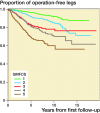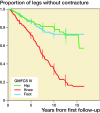Knee and foot contracture occur earliest in children with cerebral palsy: a longitudinal analysis of 2,693 children
- PMID: 33228441
- PMCID: PMC8158222
- DOI: 10.1080/17453674.2020.1848154
Knee and foot contracture occur earliest in children with cerebral palsy: a longitudinal analysis of 2,693 children
Abstract
Background and purpose - Joint contracture is a common problem among children with cerebral palsy (CP). To prevent severe contracture and its effects on adjacent joints, it is crucial to identify children with a reduced range of motion (ROM) early. We examined whether significant hip, knee, or foot contracture occurs earliest in children with CP.Patients and methods - This was a longitudinal study involving 27,230 measurements obtained for 2,693 children (59% boys, 41% girls) with CP born 1990 to 2018 and registered before 5 years of age in the Swedish surveillance program for CP. The analysis was based on 4,751 legs followed up for an average of 5.0 years. Separate Kaplan-Meier (KM) curves were drawn for each ROM to illustrate the proportions of contracture-free legs at a given time during the follow-up. Using a clustered bootstrap method and considering the child as the unit of clustering, 95% pointwise confidence intervals were generated for equally spaced time points every 2.5 years for each KM curve.Results - Contracture developed in 34% of all legs, and the median time to the first contracture was 10 years from the first examination. Contracture was most common in children with a higher Gross Motor Function Classification System (GMFCS) level. The first contracture was a flexion contracture preventing dorsiflexion in children with GMFCS level I or II and preventing knee extension in children with GMFCS level III to V.Interpretation - Early interventions to prevent knee and foot contractures in children with CP should be considered.
Figures







References
-
- Agustsson A, Sveinsson T, Rodby-Bousquet E.. The effect of asymmetrical limited hip flexion on seating posture, scoliosis and windswept hip distortion. Res Dev Disabil 2017; 71: 18–23. - PubMed
-
- Agustsson A, Sveinsson T, Pope P, Rodby-Bousquet E.. Preferred posture in lying and its association with scoliosis and windswept hips in adults with cerebral palsy. Disabil Rehabil 2018: 1–5. - PubMed
-
- Alriksson-Schmidt A I, Arner M, Westbom L, Krumlinde-Sundholm L, Nordmark E, Rodby-Bousquet E, Hägglund G.. A combined surveillance program and quality register improves management of childhood disability. Disabil Rehabil 2017; 39(8): 830–6. - PubMed
-
- Barrett R S, Lichtwark G A.. Gross muscle morphology and structure in spastic cerebral palsy: a systematic review. Dev Med Child Neurol 2010; 52(9): 794–804. - PubMed
Publication types
MeSH terms
LinkOut - more resources
Full Text Sources
Medical
Miscellaneous
